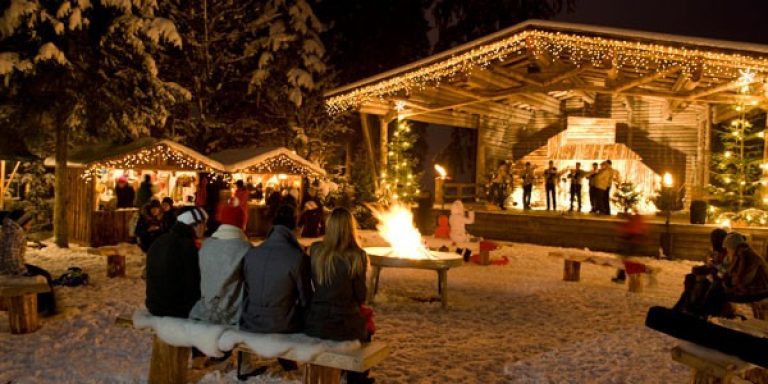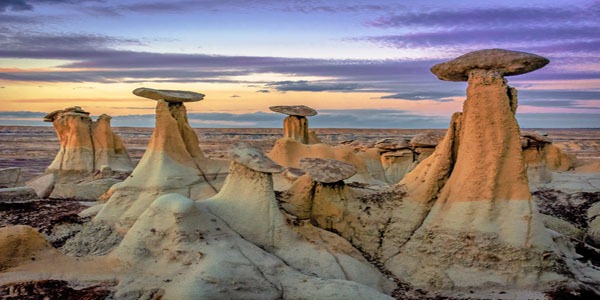National parks in Ohio are monuments to the historical and prehistoric past, including that of the great warrior Shawnee Tecumseh, statesman soldier Buffalo Charles Young, and aviation pioneer brothers Wright.
National and state parks throughout Ohio are natural playgrounds for outdoor enthusiasts, from the wooded hills of the Appalachian Mountains in the south to Lake Erie shores in the north. Ohio’s diverse geographic regions offer so many things to do all year round, from desert hiking, golf, canoeing and paddleboarding to snowmobiling, cross-country skiing and birdwatching. In any case, to appropriately plan your park trip, you will need a guide and one of these National Park Coffee Table books could be your best friend.
With two historic national parks, three national wildlife shelters and 83 state parks, you’ll find that Ohio’s changing seasons make your outdoor activities a different kind of experience every time.
According to the U.S. National Park Service, more than two and a half million visitors come to eight National Parks in Ohio each year, including monuments, memorials, historical sites, and national trails. Here are some of the most salient.
Charles Young Buffalo Soldiers National Monument in Ohio

Located in the city of Xenia, Ohio, the Charles Young Buffalo Soldiers National Monument consists of a museum housed in the former home of Charles Young, the first black leader of a late 19th century Buffalo Soldiers unit. The monument celebrates the widely varied and successful young career that measured military, education, diplomacy, and service in the park.
Charles Young (1864-1922) was a soldier, diplomat, and civil rights leader whose parents fled slavery shortly after his birth. His father enlisted in the 5th Heavy Colored Artillery Regiment in the Civil War; his mother took the family and moved to Ripley, Ohio, a town that was a strong center of the abolitionist movement.
During reconstruction, Charles went to school, where he flourished in academia, foreign languages, and music, and became the 9th African-American candidate at West Point. Upon graduation, he was commissioned as second lieutenant in the 9th ordeal at Fort Robinson, Nebraska, to fight in the Indian Wars (1622-1890) – the prolonged series of battles for possession of the Americas between European and indigenous people. After the Civil War, three regiments of black soldiers were enlisted in the Indian Wars; Young was the first African-American leader of one of these units, the 10th Cavalry, coming to the rank of captain.
After the wars ended, Young continued to fight in the Philippines and Mexico, and then had a very varied and successful career. That career included teaching military science and tactics at Wilberforce University, diplomatic attaché in Haiti and the Dominican Republic, and in 1907, Young was the first African-American named as a national superintendent park, at the redwood national park in California . He volunteered to fight in World War I – In 1914 he was 50 and demonstrably vigorous and was promoted to colonel, but was not allowed to serve.
Dayton Aviation Heritage National Historic Park in Ohio
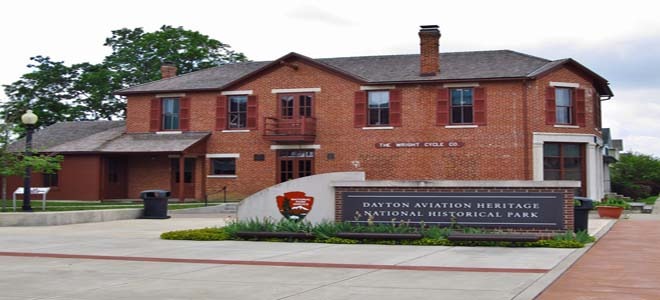
The Dayton Aviation Heritage National Historic Park, which includes the National Historic Aviation area, is located near Dayton, southwest Ohio. It is dedicated to the efforts of the famous Wright Brothers, pioneers of American aviation. One of the most visited National Parks In Ohio also features a memorial to Dayton novelist, poet, playwright, and Paul Laurence Dunbar (1872-1906).
Wilbur Wright (1867-1912) and Orville Wright (1871-1948) were two inventive and hardworking brothers who didn’t get much of a formal education, but were skilled and worked on several projects before settling on air transport.
The first of Wright’s obsessions was printing, which they established in Dayton in the late 1880s, publishing newspapers and doing press work until about 1900. One of their jobs was for Dunbar, who published Dunbar’s Dayton Chatterbox with them, an early newspaper for the African-American community in Dayton. The Wright brothers were also bicycle enthusiasts, who exploited a bicycle repair facility in a full-scale business, in the Wright Cycle Company building (1893-1908), where bicycles are repaired and sold.
Read also our New Mexico guide
When they heard that German aviation pioneer Otto Lilienthal (1848-1896) had died in an accident, they became fascinated with the possibilities of sustained flying and began their careers as inventors, entrepreneurs and patent trolls in aviation. They were the first to conduct a sustained, powered and controlled flight in the North Carolina community beach of Kitty Hawk on December 17, 1903.
The Wright’s continued their work in air transportation for a decade or more at Huffman Prairie, their airfield, some of which is included in the park’s boundaries, and signed a contract with the U.S. military to build an airplane that flies for an hour at 40 miles per hour, in 1908. which led to a successful business that included a test bench, flight school, and home to their show team.
Fallen Battlefield Timbers and Fort Miamis National Historic Site
Located near Toledo, in the northwestern part of the state, Fallen Timbers Battlefield and Fort Miamis National Historic Site includes a battlefield and museum dedicated to the 1794 Battle of Fallen Timbers.
The Battle of Fallen Timbers was fought on August 20, 1794, between the United States Major General Anthony Wayne (1745-1796, also known as Mad Anthony Wayne), and the Native American forces led by Chief Michikinikwa (1752-1812) and including the famous warrior Shawnee and chief Tecumseh (1768-1813). The battle was part of the Indian wars, in particular, a terrain problem with the American forces against the Native Americans who had been allied-British Chippewa, Ottawa, Pottawatomi, Shawnee, Delaware, Miami, and the Wyandot tribes, who had formed a federation to further stop US incursions into their territory.
Fort Miamis was a British fort built in the spring of 1794 on the Maumee River. Although the 1783 Treaty of Paris put an end to the Revolutionary War, a provision allowed the British to remain in the northwest of the Ohio River territory west of the Ohio River to resolve the land issue. The Battle of Fallen Timbers was the resolution of that provision, the Treaty of Greenville redefined the border between Indian and American lands. Tecumseh refused to sign and continued the resistance effort until his death at the Battle of the Thames in southwest Ontario.
Read also: Best things to see in New York
Hopewell Culture National Park in Ohio
The Hopewell Culture National Historic Park, located in southcentral Ohio, near the city of Chillicothe, honors the huge and graceful geometric monuments and fences built by the Middle Woodland Hopewell Culture, horticulturists and farmers who prospered in Central North America between 200 BC-500 CE .
Hopewell is a name archeologists have given to people who were part of a vast network of economic, political and spiritual beliefs through many different groups. A distinctive feature was the construction of large enclosures made of earthen walls, often in geometric patterns and surrounding other mounds, and sometimes-effigies shape: some are likely to have had astronomical features. Groups of mounds are the remains of both ceremonial and residential activities, basically closed communities. The Hopewell exchanged goods and ideas from a vast network, from the Atlantic coast to the Rocky Mountains, demonstrates the collection and production of artifacts made of materials such as obsidian, copper, mica, shark teeth, and sea shells.
Hopewell is among the most interesting National Parks In Ohio and includes several mound groups, including the City Group Mound, which is the only fully restored Hopewell embankment complex, with 13 acres rectangular earthen container surrounding 23 dome-shaped mounds.
Cuyahoga Valley National Park in Ohio
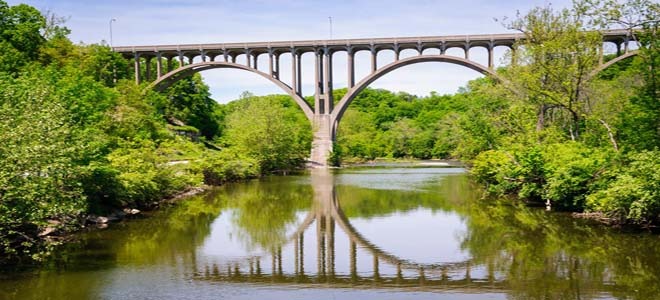
The Cuyahoga Valley National Park should be one of your first outdoor recreation visits to Ohio. The natural beauty of the park is breathtaking as you experience hills, forests, and Cuyahoga River activities winding through the park. It is hard to believe that this natural paradise is within walking distance of the urban activity of Cleveland and Akron.
The Ohio and Erie Canal Towpath Trail runs through the park for 20 miles and is a main route for bikers and joggers and one of the five main bike trails. The East Rim Mountain Bike Trail is designed for off-road use and the Summit Metro Parks paved Bike & Hike Trail is ideal for families. Since biking is a popular activity in the National Parks In Ohio, it is easy to find bike shops in the area if you need repairs. If you’re planning to take a multi-day ride on the Towpath Trail, you should contact the Park Communication Center so that your car is not marked as abandoned. Hiking trails in Cuyahoga Valley National Park cover all skill levels. You’ll find 125 miles of trails to choose from.
The small peninsula town is located within the National Park, where you can stop for a bite to eat or rest before you go on your way. You can also board the Cuyahoga Valley Panoramic Railway here for one of their themed tours throughout the year.
Read also: The best things to do in Las Vegas
Ohio’s Wayne National Forest
Wayne National Forest is one of the best opportunities to experience primitive nature in Ohio. Located on the slopes of the Appalachian Mountains, the forest covers 12 counties and over 833,000 hectares. One of the best things to do in this forest is backpacking through undulating terrain and waterways. Private land is scattered throughout the park, so it’s important to keep an eye out for signs on private property if you’re planning a long hike.
The place is known as one of the best National Parks In Ohio and offers plenty of opportunities for hiking and biking, with over 300 miles of trails. Off-road vehicles (ATVs) and horse riders are allowed on many trails, but these activities require proper permits.
Camping in Wayne National Forest can take many forms. A lot of camping sites within the park do not require reservations. Primitive camping is also allowed away from regular campsites. You must pack all necessities, including water, for the duration of your stay. Due to the large amount of land covered by this park, it is advisable to research the layout and get an idea of the trails or permit requirements before your visit.
Hocking Hills State Park in Ohio
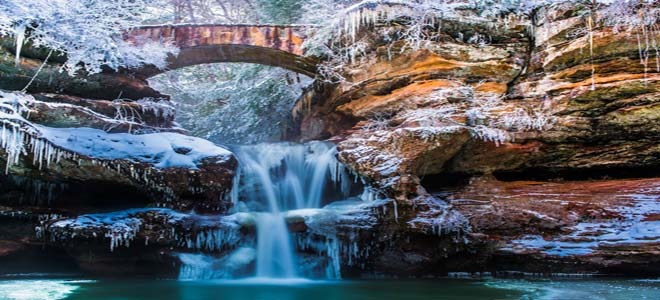
One of the most popular recreation and escape national parks in Ohio is Hocking Hills State Park. It is located in one of the quietest areas in the state and features waterfalls, caves, sandstone cliffs and lush vegetation. Autumn is the most popular time for escapes to the park, so if you plan to visit the weekend and stay in a nearby cabin, make reservations as soon as possible. Some cabins book a year in advance.
The park has five main hiking areas to explore, each with several trails that can accommodate various skill levels. Old Man’s Cave is usually the first stop for new hikers in the area, so the trails are more congested, especially on weekends. Other sites to visit include Cantwell Cliffs, Conkle’s Hollow, Cedar Falls, and Rockhouse.
Hocking Hills has a full menu of outdoor recreational options including canoeing, zip-lining, horseback riding, and rock climbing. These activities are offered by independent operators in the area. It is worth spending time at the visitor center to enter the park to get maps and tips for reputable hiking companies.
Ohio’s Maumee Bay State Park
Maumee Bay State Park is located on the shores of Lake Erie and is one of the most naturally diverse places in the state, with swamps, wetlands and meadows. Water activities such as rowing, fishing, swimming and paddle boarding are usually combined with land-based activities during a visit. The state park has numerous recreational trails, including specific routes for backpacking, mountain biking, off-road vehicles (ATVs) and snowmobiles. Cycle paths and horse riding trails are easy to find, and a golf course is also on the ground.
One of the most popular activities in this national park in Ohio is bird watching as over 300 species of birds have been identified in the area, including nesting pairs of bald eagles. The park is located along part of the 312-mile Lake Erie Birding Trail. Every spring, thousands of birdwatchers come to the area for The Biggest Week in American Birding to watch the migration of torpedoes.
Read also: Which is the best travel magazine?
Salt Fork State Park in Ohio
Ohio’s largest state park is Salt Fork in Guernsey County, with over 17,000 acres of recreational activities. People travel here for abundant hiking, horseback riding, fishing, camping, swimming and rowing. One of the unique features here is a 10-station archery course that is easy to navigate and easy to find near the entrance to the park.
The Salt Fork reservoir is a lake of nearly 3,000 acres which makes it one of the main attractions of the region. There are two marinas, and the lake has plenty of space for boating, water skiing and fishing. Salt Fork also has one of the largest inland beaches in Ohio, stretching over 2,500 feet, with modern facilities such as showers and lockers, so it’s convenient to spend a day.
The Ohio national park has 14 hiking trails with varying degrees of difficulty. Some of these trails are converted into snowmobile trails in winter.
John Bryan State Park in Ohio
One of Ohio’s most scenic state parks is John Bryan, which hides a spectacular limestone gorge carved by the Little Miami River. Several lookouts allow you to peer through the layers of fresh rock into the water that flows more than a hundred feet below. Part of the gorge has been designated a national landmark.
This Ohio national park is a peaceful setting for picnics or a game of golf on the 18-hole golf course, but the main feature and reason to go is the network of hiking trails. With nine trails throughout the 752-acre park, it’s easy to spend a full day exploring nature and nature. John Bryan is one of the best winter hiking parks in the state, where you can catch frozen waterfalls halfway down.
If you’re visiting for a full day, park at the entrance near Yellow Springs then hike along the main trail that leads you through the Clifton Gorge Nature Preserve. The end of the trail leads to a road and the Clifton Mill, where you can rest and enjoy breakfast or lunch before heading back. Plan four to six hours for this trek.
Malabar Farm State Park
Malabar Farm is a popular Ohio state park and one of the most unique to visit. It was the creation of the dream of Pulitzer Prize winning author Louis Bromfield. The park is actually a farm with a main house and outbuildings. The beautiful farmhouse is where Humphrey Bogart and Lauren Bacall exchanged wedding vows in 1945. You will find memorabilia that highlight this taste of Hollywood throughout the 32-room house.
The Malabar Farm grounds are open for discovery, with multiple buildings and fields with cattle, chickens and goats. Throughout the year, special events are open to the public and wagon tours are offered throughout the farm during the summer.
There are two first times to visit the farm: in the fall, when the leaves are changing color on the rolling hills of Richland County, and in the spring during the Maple Syrup Festival, when the trees produce sap, and you can indulge in new Ohio Syrup.
Kelleys Island State Park in Ohio
Accessible only by ferry, Kelleys Island is a geologically stunning state park surrounded by Lake Erie which is an ideal destination for recreation and relaxation. The campsite offers electric and non-electric sites, a picnic hut, volleyball court and playground. Games hire is available at the campsite office. If you are looking for a truly unique accommodation, several large yurts are available in the park.
Hiking around the island is easy with various lengths of paths. There are four miles of multi-purpose bike trails. The 100 foot public beach is popular in the warmer months. Rowing and kayaking are also popular summer spots.
While visiting the island in the summer is ideal, it is also beautiful during the winter. Weather permitting and with warm layers, visitors to the island can enjoy seasonal ice fishing, ice skating and cross-country skiing.
Deer Creek Ohio State Park
The diversity of landscapes and wildlife in Deer Creek is what makes it a state park to visit in Ohio. The landscape around the 2,300-acre park consists of meadows, forests and an abundance of wildflowers. No wonder hiking is a major attraction, with seven hiking trails. The park also has a 17-mile horseback trail. The Deer Creek public golf course covers 350 acres with 10 ponds. A nine-hole golf course winds through scenic terrain.
The main attraction of this park is the Deer Creek reservoir, famous for boating, kayaking, paddle boarding, fishing and swimming. The large beach has plenty of space, so it is rarely crowded. You will find plenty of barbecues and picnic tables available.
Campsites, cottages, cabins and a lodge offer a range of rustic to modern accommodation, and two unique campsites accommodate large groups, up to 100 people, as well as riders.
Geneva State Park in Ohio
On the north-eastern shores of Lake Erie, Geneva’s state park is one of the most convenient for recreational activities as there is so much to do in a nearby location and tourist attractions. The marina within the state park is within walking distance of most of the accommodation, so it is easy to book fishing charters for walleye and perch without having to go far. The marina rents paddle boards and jet skis on site.
A six-mile multi-use trail connects all aspects of the park to a 300-foot public beach, with lifeguards on duty during rush hours. The trails are home to hiking and biking and become snowmobiles and cross-country trails in winter.
Accommodation options include a campsite, cabins, lodge and cottages, all with easy access to the state park. When you need a break from hiking, Geneva on the lake is a small seaside resort at the end of the road worth a visit for lunch or dinner. The mile long strip is full of old arcades and an eclectic mix of shops, taverns and donut shops that have existed for over 60 years.
Tar Hollow State Park
The Ohio State Park that offers some of the funniest opportunities for exploration is Tar Hollow for its winding paths through hills, forests and steep cliffs. This park in southern Ohio encapsulates the true sense of wilderness with its dense forests.
Tar Hollow is best for greedy hikers, with most trails averaging several miles. Novice hikers are able to walk the terrain and enjoy the scenery, but it’s advisable to take a map before engaging in a trail. In addition to hiking trails, dedicated bike paths and 25 miles of bridle paths run through the park. Serious backpackers can take the 21-mile Logan Backpacking Trail for a challenging trek through the forest. Backpacker camping is available at Logan Hollow Campground by reservation only. Pine Lake is a small 15-acre lake in the park that is a hidden gem for canoeing, rowboating and kayaking. There is also a beach for swimming. The best time of year to visit Tar Hollow is in the fall, when the dense forest turns into a spectacle of color.


